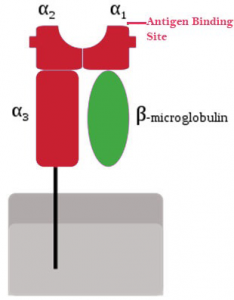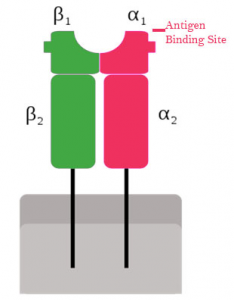| To trigger an immune response,antigen processing requires not only the fragmentation of antigen molecule inside cells but also the binding of these fragments to an appropriate antigen presenting molecules called histocompatibility molecules. Histocompatibility molecules are specialized receptor glycoproteins coded for by genes located in a gene complex called the Major Histocompatibility Complex (MHC).The receptors therefore are also called MHC molecules.The genes in the MHC determines which antigens are processed and presented.MHC is an organized cluster of genes that control antigen processing and presentation . MHC provides major genetic component of infectious or autoimmune disease resistance and susceptibility.All vertebrates possess MHC genes and are maintained in the genome as linked sets.Each MHC contains three classes of genes:1.Class I genes code for MHC molecules found on the surface of non-nucleated cells (red blood cells in some species) lymphocytes, granulocytes platelets, granulocytes, hepatocytes,kidney cells.2.Class II genes code for MHC molecules found primarily on the surface of antigen presenting cells (macrophages, dendritic cells, B-cells and on activated /resting T cells. Larger amount on renal vascular endothelium and glomeruli-significance in graft rejection .3.Class III genes code for proteins that belong to complement system.Also codes for many different proteins with a variety of functions i.e.,Tumor necrosis factor,Heat shock proteins. 1.MHC Class I A.Class Ia:Class Ia proteins are found on the surface of most nucleated cells. In pigs-lymphocytes, platelets,granulocytes, hepatocytes, kidney cells and sperms (high concentrations on lymphocytes & macroph ages) Mouse-red blood cells (exception). |
| Structure: MHC Class Ia molecules consists of two peptide chains.one chain called a-is non-covalently linked to a much smaller chain called b2Microglobulin (b2M).The a chain is inserted in the lipid bi-layer of cell surface.a chain contains three extracellular domains a1,a2 & a3 each about 100u long .b2M consists of a single extracellular domain.The antigen binding site on these molecules is formed by the a1 & a2 domains.The domain attaches this receptor like structure to the cell membrane and b2M components stabilizes the structure. |
MHC Class I Structure  |
| Gene arrangement:Each mammal has 2-3 Class Ia gene loci,within each loci are multiple genes whose number varies between species. e.g., Human – A,B,C.(20 genes) Mice – K & D (3 genes) Pig – (6 genes).Few of these genes are functional rest are pseudogenes.Polymorphism: Class Ia molecule shows great polymorphism i.e.,their aminoacid sequences are very variable.B.Class Ib: Class Ib gene code for proteins found on the surface of regulatory and immature lymphocyte and on haemopoietic cells.Shape similar to Class Ia & do have antigen binding groove. Gene arrangement: Mice – Q,T & M. Non-polymorphic. |
|||||||||||
| 2.MHC Class II:Class II proteins are found onIn Lab Rodents: on B cells,dendritic cells or macrophages (on professional antigen processing cells). Dog,Cats & Horses:on all resting adult T-cells.
Cattle:Only on B cells & activated T cells.(Exception:BoLA Class II molecule is found on thymic epithelial cells & on professional antigen processing cells). Pigs:Resting T cells,boar sperms (low concentration),Large amount of MHC Class II molecules on renal vascular endothelium and glomeruli-Significance in kidney graft rejection. Expressing MHC Class II molecules-enhanced in rapidly dividing cells and cells treated with interferon. |
|||||||||||
MHC Class II Structure |
|||||||||||
| Structure: MHC Class II molecules are glycoproteins consisting of two non covalently linked polypeptide chains called a and b.Each chain consists of two extracellular domains,connecting peptide,a transmembrane domain and cytoplasma domain.A third chain g/invariable chain is associated with intracellular Class II molecules. | |||||||||||
| Gene arrangement:Five loci arranged in order DP,DN,DO,DQ &DR.within each locus,the genes for the a chain are designated A & the genes for the b chains are called B.Antigen binding groove is formed jointly by their a1 & b1 domains.Walls are formed by two parallel a helices and its floor consists of B-pleated sheets.Polymorphism results from variations in a sequence in a helices. | |||||||||||
| 2.MHC Class III:Codes for proteins with great variety of functions.Code for proteins belonging to the complement system.There are four genes for complement in class III regioni.e., two for C4,one each for B &C2.Other loci code for :i.Enzymes-21 hydroxylase A & B,ii.Tumour Necrosis Factor a & b.(TNF-a &TNF-b),iii.Heat shock proteins-70 (HSP-70). | |||||||||||
MHC Of Domestic Animals:
MHC molecules and disease:The function of MHC molecules is to present antigen to the immune system. MHC genes regulates the immune function.In order to stimulate immune response antigen has to bind to the groove of atleast one of the MHC molecules,otherwise it will not stimulate an immune responseThese genes influences susceptibility to disease in which immune responses play a significant role. Evidences: Cattle:Possession of certain BoLA allele-Resistance to bovine leucosis,squamous cell carcinoma and Trypanosomiasis and susceptible to Tick Boophilus microplus. BoLA AW7 -Resistance to Bovine Leukemia Virus. BoLA AW12-Susceptible to Bovine Leukemia Virus. BoLA –Also controls B cell proliferation and expression of Bcell tumours . BoLA aw16-Resistance to mastitis.(M-epitope present on AW16)[presence of blood group M-resistance to mastitis] Horses: ELA AW7-Susceptible to Culicoides,hypersensitivity ELA A3,A15,DW13-Development of sarcoid tumours. SLA4,5&20-Low growth performance in large white pigs. SLA1,15&18-High carcass fatness in Landrace. Chickens: B2,6,14,21-Associated with resistance to Marek’s disease. B3,5,15 &19- Associated with susceptibility to Marek’s disease. Selection for specific HCM has great potential for use in genetic selection of disease resistant strains of domestic animals. |
|||||||||||
